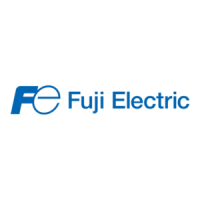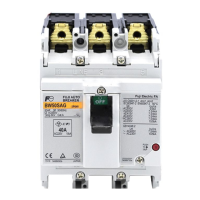Do you have a question about the Fuji Electric BW1000RAE and is the answer not in the manual?
Overview of low-voltage circuit faults and protection measures.
Explanation of overcurrent faults and protection principles.
Details on phase-loss faults and protection mechanisms.
Types of overcurrent tripping and factors affecting them.
How short-circuit currents are broken and related performance metrics.
Test conditions and results for overload switching performance.
Temperature rise and internal resistance/power consumption at rated current.
Switching durability and trip switching durability of MCCBs.
Requirements for power frequency and impulse withstand voltages.
Data on operating forces and angles for different breaker types.
Key factors to consider when selecting MCCBs for low-voltage circuits.
Conditions and criteria for implementing cascade (backup) trip coordination.
How to achieve selective trip coordination between breakers and fuses.
Protecting wiring from heat generated by overcurrents using MCCBs.
Applying MCCBs for motor overload and short-circuit protection.
Selecting MCCBs for transformer primary circuits, considering inrush current.
Selecting MCCBs for arc and resistance welder circuits, considering intermittent operation.
Considerations for MCCB selection in capacitor circuits, including arc reignition and inrush current.
Protecting semiconductor devices like thyristors from overcurrents.
Using MCCBs to protect Solid State Contactors (SSCs) in heater circuits.
Protecting inverter circuits from overcurrents using MCCBs.
Specific MCCBs recommended for 400Hz circuits, considering derating due to skin effect.
Using MCCBs in DC circuits, considering modified operating characteristics.
Selecting MCCBs for UPS systems, considering overload withstand and capacity.
Installing MCCBs for servo amplifier power supply switching and protection.
Ground fault protection methods and their application in system design.
Standard operating conditions for FUJI MCCB performance as per IEC 60947-1.
Guidelines for using MCCBs in high-temperature, cold-climate, and high-altitude environments.
Important precautions for connecting MCCBs, including reversed connection and tightening torque.
How to prevent MCCB malfunction caused by transient inrush currents like motor starting.
Troubleshooting common faults occurring during MCCB operation and their causes.
Procedures for initial and periodic inspections to maintain MCCB performance.
Guidelines for MCCB deterioration diagnosis and replacement based on durability.
Steps and formulas for calculating short-circuit current in electrical systems.
Overview of low-voltage circuit faults and protection measures.
Explanation of overcurrent faults and protection principles.
Details on phase-loss faults and protection mechanisms.
Types of overcurrent tripping and factors affecting them.
How short-circuit currents are broken and related performance metrics.
Test conditions and results for overload switching performance.
Temperature rise and internal resistance/power consumption at rated current.
Switching durability and trip switching durability of MCCBs.
Requirements for power frequency and impulse withstand voltages.
Data on operating forces and angles for different breaker types.
Key factors to consider when selecting MCCBs for low-voltage circuits.
Conditions and criteria for implementing cascade (backup) trip coordination.
How to achieve selective trip coordination between breakers and fuses.
Protecting wiring from heat generated by overcurrents using MCCBs.
Applying MCCBs for motor overload and short-circuit protection.
Selecting MCCBs for transformer primary circuits, considering inrush current.
Selecting MCCBs for arc and resistance welder circuits, considering intermittent operation.
Considerations for MCCB selection in capacitor circuits, including arc reignition and inrush current.
Protecting semiconductor devices like thyristors from overcurrents.
Using MCCBs to protect Solid State Contactors (SSCs) in heater circuits.
Protecting inverter circuits from overcurrents using MCCBs.
Specific MCCBs recommended for 400Hz circuits, considering derating due to skin effect.
Using MCCBs in DC circuits, considering modified operating characteristics.
Selecting MCCBs for UPS systems, considering overload withstand and capacity.
Installing MCCBs for servo amplifier power supply switching and protection.
Ground fault protection methods and their application in system design.
Standard operating conditions for FUJI MCCB performance as per IEC 60947-1.
Guidelines for using MCCBs in high-temperature, cold-climate, and high-altitude environments.
Important precautions for connecting MCCBs, including reversed connection and tightening torque.
How to prevent MCCB malfunction caused by transient inrush currents like motor starting.
Troubleshooting common faults occurring during MCCB operation and their causes.
Procedures for initial and periodic inspections to maintain MCCB performance.
Guidelines for MCCB deterioration diagnosis and replacement based on durability.
Steps and formulas for calculating short-circuit current in electrical systems.
| Rated Current (In) | 1000A |
|---|---|
| Rated Voltage (AC) | 690V |
| Breaking Capacity | 65kA |
| Trip Unit | Electronic |
| Mounting | Fixed |
| Standards | IEC 60947-2 |
| Poles | 3 |










